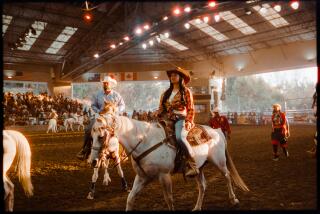The ‘Wild’ western
- Share via
Though some critics hated it when it was released in 1969, Sam Peckinpah’s seminal western “The Wild Bunch” is today considered one of the most influential, poetic -- and yes, violent -- sagebrush sagas ever made.
“The Wild Bunch” changed the face of filmmaking with its bloody scenes shot in slow-motion from multiple angles and its innovative, quick-cut editing style. Many have imitated the violence, but few have been able to capture its spirit and beauty.
“It’s something you will never see in a western before, and you will never see it again,” says Ernest Borgnine, who played the vicious outlaw Dutch Engstrom in the film.
“The Wild Bunch” is riding into town for a special 40th-anniversary screening Thursday at the venerable Million Dollar Theater in downtown L.A. Jean-Christophe Jeauffre and Frederic Dieudonne, founders of the Jules Verne Festival, are presenting the screening, with all proceeds going to the Jules Verne Nature & Education Program.
On hand for the evening will be some of the film’s stars -- Borgnine, Bo Hopkins, L.Q. Jones and Alfonso Arau. Borgnine will be receiving an award from the festival for his performance in the film; Melissa Peckinpah will be accepting a special award for her father, who died 25 years ago; and the family of the late composer Jerry Fielding will be on hand to accept a lifetime achievement award.
“The Wild Bunch” is set in 1913 and revolves around a gang of aging outlaws near the Texas-Mexico border who have outlived their time. William Holden plays the leader of the group, Pike Bishop, who wants to pull off one last robbery before he retires. But he’s ambushed by his former partner (Robert Ryan) and his deputized bounty hunters.
“The Wild Bunch” was the pinnacle in Peckinpah’s career. He continued to make movies but never achieved the same success. He died in 1984 at 59.
We talked with some of the participants and film scholars about the movie:
--
L.Q. Jones
Peckinpah’s friend, who played T.C.
“If you look at it, he made ‘The Wild Bunch’ several times, starting with ‘Deadly Companions,’ ‘Ride the High Country,’ ‘Major Dundee,’ ‘The Cincinnati Kid,’ ‘Noon Wine.’ Then he finally gets to the ‘Bunch.’ He was so happy being allowed to make it that he kind of went overboard. For its time, it was probably the most violent picture made.
“Sam didn’t belong. There is a [judge and congressman] in his family. His dad is an attorney. The whole family is well educated, well spoken and rather reclusive, certainly Republican in their attitude. And along comes Sam.
“I think he scared the hell out of them, including himself.”
--
Bo Hopkins
Played Crazy Lee
“Sam couldn’t have been nicer. When they were shooting, I was on the set every day to watch and observe all the guys doing their stunts. They took time to show me how to throw punches and how to take a punch and how to always tell the stunt coordinator what you can and cannot do.
“I was so nervous on the movie. I didn’t know one thing about Peckinpah, but I did know about Bill Holden, Robert Ryan and Ernie Borgnine. Holden and Ernie Borgnine were like fathers to me. Ernie still is.”
--
Ernest Borgnine
Played Dutch Engstrom
“Sam loved actors. He would spend hours with actors. But anybody behind the camera who didn’t do what he wanted -- bam, they were out.
“He said he was looking for perfection. That was the way Sam was. He was the most easygoing fellow I have ever worked with, but, boy, when he wanted something, he got it.”
--
Nick Redman
Peckinpah scholar
“I think before ‘The Wild Bunch’ he was one kind of nut, and then after he became a more serious kind of nut because now he was ‘Bloody Sam.’
“He had this reputation. He felt compelled to live up to his notorious reputation. That is what has really harmed his legacy. He allowed himself to make sometimes sort of trashy things in order to keep perpetuating this myth.
“ ‘The Wild Bunch’ is violence with responsibility. There are consequences to your actions. And what all subsequent imitators forget to bring in. It was an antiwar film. It was almost a Vietnam allegory. There has to be a reason that 40 years and two generations later, it is hailed as a masterpiece the same way people talk about ‘The Bicycle Thief’ or ‘Citizen Kane.’
“It transcends its commercial value. It’s up there nailed to the wall as a very big piece of art, like a Francis Bacon painting.”
For information go to www.julesverne.org.
--
More to Read
Only good movies
Get the Indie Focus newsletter, Mark Olsen's weekly guide to the world of cinema.
You may occasionally receive promotional content from the Los Angeles Times.











